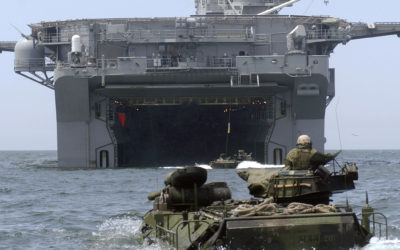On April 26, U.S. President Joe Biden welcomed South Korean President Yoon Suk-yeol to the White House for a summit meeting to celebrate the seventieth anniversary of the U.S.-South Korea alliance and open a new chapter for the next seventy years of expanded cooperation. Amid a substantial list of topics discussed by the two leaders, extended deterrence emerged as the top deliverable.
On 24 February, marking one year since Russia’s all-out invasion of Ukraine began, China’s Ministry of Foreign Affairs published China’s position on the political settlement of the Ukraine crisis. In theory, its 12 points form the basis for peace negotiations that Beijing—perhaps President Xi Jinping himself—could broker. With this plan, Beijing is positioning itself as a peacemaker and neutral party to the conflict. Nothing could be further from the truth.
The peace plan is a cynical attempt to help Russian President Vladimir Putin, hamper support for Ukraine, bolster Beijing’s image in the global south, and distract from the reality of growing Chinese support to Moscow. That includes economic support as Russia’s largest trading partner and concerns that Beijing may start providing arms to the Russian side. The organising principle throughout the plan is self-interest, notably leveraging war in Europe to support Beijing’s aims for reshaping the Indo-Pacific.
First, we must recognise that this plan is biased. Just as Putin visited Beijing to consult with Xi days before launching his offensive last year, Chinese Foreign Minister Wang Yi was in Moscow days before this plan was released. Despite Russian denials, it’s probable that the plan was discussed, especially as its existence had already been trailed by Wang at the Munich Security Conference. By contrast, we know that Beijing didn’t consult Kyiv about this 12-point plan or its earlier manifestation as four principles.
The most glaring omission in Beijing’s plan is the failure to mention Russian aggression. When quizzed on this point, China’s foreign ministry spokesperson said, ‘Our position is clear. We stand on the side of peace and dialogue, and on the right side of history.’ Clear as mud, and consistent with Beijing’s ongoing strategy of obfuscation.
In fact, as ASPI research shows, Beijing has long amplified Russian disinformation blaming the West for the war. This is alluded to in the 12 points, which caution against a ‘Cold War mentality’ and ‘expanding military blocs’. The spokesperson was less veiled in pointing the finger: ‘Stoking bloc confrontation leads to conflict and war … We have seen what NATO has done to Europe and it must not seek to sow chaos here in the Asia–Pacific or elsewhere in the world.’
At first blush, there are attractive elements among the 12 points, such as respect for sovereignty, territorial integrity and international law (point 1). But if we keep in mind Beijing’s concealment of Russian responsibility for the war, then the whole shabby edifice crumbles point by point. If Beijing cared about the UN charter, why doesn’t it call out Russia’s blatant violation of it? Instead, China abstained on the UN General Assembly resolution calling for Russian forces to leave Ukraine.
Such duplicity lurks behind the espousal of laudable principles throughout the plan. If Beijing wants to alleviate suffering (point 5), why is it failing to provide bilateral humanitarian aid to Ukraine? If Beijing cares about humanitarian law (point 6), why did it vote against the Human Rights Council resolution that set up a commission of inquiry into war crimes in Ukraine? If Beijing supports nuclear safety (point 7), why is it undermining trust in the International Atomic Energy Agency by challenging its objectivity in the context of the AUKUS agreement? And if Beijing is committed to reducing strategic risks around nuclear weapons (point 8), why has it failed to condemn Russia’s suspension of the New START Treaty?
The truth is that Beijing only observes the principles underpinning international order to the extent that they serve its interests. Kyiv and the community of countries helping Ukraine defend itself already uphold these principles, while Moscow patently doesn’t. Beijing’s plan overlooks this inconvenient truth and instead implies moral equivalence between the warring parties, seeking to bolster the myth that it could act as an honest, even-handed broker in peace negotiations.
Throughout the plan, Beijing has sought to manipulate the war in Ukraine to maximum strategic advantage. The clearest example is point 10, which calls for a stop to sanctions not endorsed by the UN Security Council. Russia’s veto on the council aside, Beijing’s moral high ground over the lawfulness of unilateral sanctions is paper thin. It has equivalent regimes and, as ASPI research has shown, makes widespread use of non-transparent economic and other levers for ‘coercive diplomacy’—a term that Beijing has adopted to criticise the US. Beijing’s sustained invective against sanctions is motivated largely by concern that the West could use similar measures against China, including to deter or punish attempts to forcibly change the status quo across the Taiwan Strait.
Beijing’s proposals for a ceasefire and peace talks (points 3 and 4) are also self-serving. Were the plan realised based on the current reality on the ground, Russian territorial gains would be crystallised. This provides no basis for a just and durable peace. The result would be a frozen conflict, which Russia could restart at a time of its choosing, as we’ve seen with its salami-slicing tactics since 2014. A simmering conflict suits China because a durable peace in Europe could allow the US and some NATO partners to focus more on maintaining stability in the Indo-Pacific, potentially stymieing Beijing’s ambitions for Taiwan.
As Russia seemingly flounders, Beijing will fear that Ukraine might achieve its war aims, which are clearly stated by President Volodymyr Zelensky in his 10-point ‘formula for peace’ and include the full withdrawal of Russian forces from Ukraine. Such an outcome would invigorate Western confidence and solidarity. The paranoid Chinese Communist Party may even fear that its grip on power could be threatened by precedence if Putin’s failure in Ukraine precipitated a power transition that shifted Russia back towards the West and democracy.
Despite its flawed plan, Beijing cannot be sidelined—attempting to do so would be counterproductive and might exacerbate the risk of China arming Russia. Zelensky has every right to seek a meeting with Xi, who has the means if not the intent to tell Putin some home truths about his failed gambit in Ukraine. It is telling that Xi has dodged a meeting or phone call so far. Western ministers will also continue to engage their Chinese counterparts, lobbying for Beijing to play a more responsible role.
Xi has the means to help bring about peace in Ukraine. He could back Zelensky’s 10-point plan. He could call out Russian aggression and use China’s economic and political leverage to force Putin to call back his troops. Beijing’s 12-point position is a cynical diversion from the task at hand.
Republished from the Australian Strategic Policy Institute under a Creative Commons license in the Commonwealth of Australia. Read the original article.

Alex Bristow is deputy director of ASPI’s defence, strategy and national security program.
Related Articles
President Marcos Jr. Meets With President Biden—But the U.S. Position in Southeast Asia is Increasingly Shaky
Over a four-day visit to Washington, Philippine President Ferdinand Marcos Jr. has been welcomed to the White House and generally feted across Washington. With President Biden, Marcos Jr. (whose father was forced out of office in part through U.S. pressure, and whose family has little love for the United States) affirmed that the two countries are facing new challenges, and Biden said that “I couldn’t think of a better partner to have than [Marcos Jr.].”
The U.S. is about to blow up a fake warship in the South China Sea—but naval rivalry with Beijing is very real and growing
As part of a joint military exercise with the Philippines, the U.S. Navy is slated to sink a mock warship on April 26, 2023, in the South China Sea.
The live-fire drill is not a response to increased tensions with China over Taiwan, both the U.S. and the Philippines have stressed. But, either way, Beijing isn’t happy – responding by holding its own staged military event involving actual warships and fighter jets deployed around Taiwan, a self-governed island that Beijing claims as its own.



